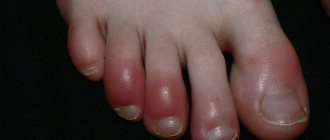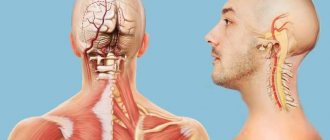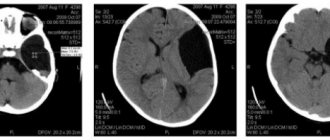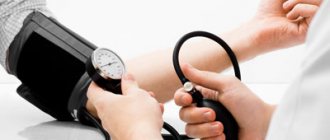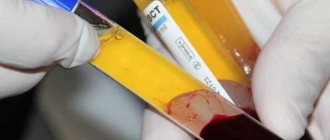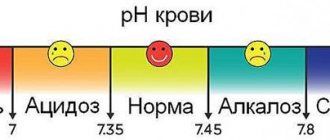Young parents often try to figure out their baby’s tests on their own. And they get stuck in medical names and standards. Today we will talk about one of the components of a blood test - monocytes, what their norm is in children, what monocytes are in a blood test, etc.
- Role of monocytes
- Norms for children
- Main reasons for the increase
- Diagnostics
- Treatment
Monocytes are elevated in a child, what does this mean?
Elevated monocytes speak of many diseases; of course, there is a list that is directly related to this elevated level in the blood. I will return to these diseases a little later, now I want to make notes on the main thing.
First of all, in order to understand what elevated monocytes mean, you need to know what they are responsible for in the child’s body and what their role is. Platelets, monocytes and all other indicators directly tell us about problems in the body, in this case in children. It should be remembered that every cell in the blood performs a specific task.
What are monocytes responsible for in the blood?
Monocytes are the most common cells, they are also responsible for the protective layer of our body, and in this case, the child’s. They prevent the entry of germs and microorganisms that can harm the health of the baby. Their habitat is blood, lymph nodes and tissues. Monocytes are much larger than leukocytes, although they are a type of them.
Monocytes cleanse the blood of parasites, destroy foreign bodies and dead and foreign cells. The role of monocytes in children's blood is the same as in adults; these particles work the same regardless of a person's age. In a general blood test, it is indicated as a percentage. If the percentage is too high, the doctor diagnoses the child with monocytosis.
Monocytes are normal in children
Already at birth, blood is taken from infants for analysis, according to which doctors assess the general condition of the newborn. In the future, for each disease, this type of analysis is also prescribed. It is after decoding that the doctor makes a diagnosis. The norm of monocytes in children differs from the norm of adult women and men. Each age has a certain percentage of these large leukocytes.
- At birth in infants, this figure is 3–5%;
- From one to 12 years, the percentage increases, and this figure can reach 12%;
- From the age of twelve until the age of 18, monocytosis is not diagnosed if the figure is not higher than 11%;
- After reaching adulthood, children reach the adult norm, no more than 8%.
It also happens that monocytes are lower than normal, this is due to exhaustion of the body, or such a change occurs due to a hormonal background. Elevated monocytes in a child indicate the presence of a disease.
Reasons for deviation from the norm
An increase in monocytes is called monocytosis. Its absolute form (expressed in quantitative units) is considered a more alarming sign than its relative form. Deviation from the norm to a lesser extent is monocytopenia. This condition is more dangerous than monocytosis, since it indicates serious suppression of the immune system.
Monocytosis
The phenomenon is said to occur when the number of guard cells exceeds a threshold value for each age group. Two types of condition:
- Absolute monocytosis. Occurs when the number of monocytes in the blood increases. In the absolute form, the concentration of protective cells in adults goes beyond 0.8 x 109/l, in children under 12 years old - 1.1 x 109/l.
- Relative monocytosis. With this phenomenon, the absolute number of phagocytes remains normal, but their percentage in the leukocyte formula increases. This indicates a decrease in the proportion of other types of leukocytes.
Increased monocytes in the blood of a child
The phenomenon is often observed after acute infections. The increase is short-term, and the number of monocytes quickly returns to normal after the body is restored. Other diseases/conditions can also cause monocytosis:
- viral infections: measles, mumps, infectious mononucleosis;
- helminthic infestations with roundworms, lamblia;
- fungal infections: lichen, candidiasis, stomatitis, deep mycosis;
- teething, replacement of milk units with molar ones;
- autoimmune diseases: systemic lupus erythematosus, scleroderma, juvenile rheumatoid arthritis, type 1 diabetes mellitus;
- inflammatory bowel diseases: ulcerative colitis, Crohn's disease;
- different types of leukemia: monoblastic, myeloblastic, chronic monocytic and myelomonocytic;
- granulomatous pathologies: tuberculosis, syphilis, brucellosis, sarcoidosis;
- intoxication with tetrachloroethane, phosphorus, heavy metals, intake of haloperidol, griseofulvin.
Analysis of the content of monocytes along with other types of leukocytes is of diagnostic importance. Examples of deciphering blood test results:
- Monocytes and lymphocytes are increased. This indicates the development of ARVI and childhood infectious diseases.
- Monocytes and eozonophils are increased. The combination indicates the occurrence of allergic reactions or the introduction of parasites. Based on additional research, the doctor can make the following diagnoses: atopic dermatitis, hay fever, ascariasis, giardiasis, bronchial asthma. More rare cases of this picture are an indicator of leukemia or lymphoma.
- Monocytes and basophils are increased. Indicate allergic reactions, the development of inflammatory processes or autoimmune diseases.
- Monocytes and neutrophils are increased. A common picture that indicates bacterial and fungal infections.
- The ratio of MON and LYM (lymphocytes) in absolute numbers is greater than one. This is one of the diagnostic signs of active tuberculosis. As recovery progresses, the rate drops to 0.3–0.8.
To make an accurate diagnosis, the doctor prescribes one or more additional tests: a general urine test, coprogram, culture of vomit, ultrasound of the abdominal organs, serological tests, rheumatic tests, bone marrow puncture (if cancer is suspected). Relative monocytosis indicates experienced illnesses, injuries, stress, and individual characteristics of the organism.
Article on the topic: Aleron - instructions for use, indications, dosage, composition, price
Monocytosis in adults
The reasons for this phenomenon are the same as in children. The following diseases and conditions are added to the above list:
- infection in the heart - endocarditis;
- alcoholic cirrhosis of the liver;
- injuries of the musculoskeletal system, previous surgical operations;
- chronic indolent infections – monocytes are elevated for 6–8 weeks or longer;
- oncohematological pathologies (myeloma) – there is a sharp increase in macrophages (up to 30–50 x 109/l).
Monocytosis during pregnancy is normal. It occurs in the early stages, when the body adapts to a new state, and at the end of the third trimester. The immune system is activated to provide the body with strong defense against pathogens. If the deviation is significant, the woman needs to undergo additional examinations.
Monocytopenia
Deviations from the norm to a lesser extent indicate suppression of the immune system and suppression of the thymus gland. A person feels weak, lethargic, chills, and his temperature rises. The nature of other symptoms depends on the disease that caused the monocytopenia.
Monocytes are low in a child
The relative form of the phenomenon indicates stress, surgery, or trauma. Long-term use of medications (corticosteroids, cytostatics) can also cause monocytopenia. The child experiences exhaustion and loss of strength – a consequence of the body’s low resistance. Monocytopenia occurs with the following diseases and conditions:
- Severe infectious and inflammatory processes that are complicated by purulent inflammation and sepsis: boils, carbuncles, osteomyelitis, bacterial pneumonia.
- Aplastic anemia is a severe hematopoietic disorder in which the synthesis of blood cells is inhibited or completely stopped.
- Late stages of oncohematological diseases. During this period, inhibition of all hematopoietic germs is noted and pancytopenia develops. The immune system is severely depleted, and the child often develops concomitant diseases.
- Received radiation and chemotherapy.
- Hormonal therapy - long-term use of prednisolone and dexamethasone.
- Disorders of the endocrine system - diseases of the thyroid gland.
- Severe exhaustion of the body from insufficient food.
- Congenital and acquired immunodeficiency.
- Advanced stage of helminthic infestation.
- Severe chemical poisoning.
Reasons for the decrease in monocytes in the blood in adults
They do not differ from the reasons indicated for childhood. When monocytes are low in an adult, this means that the body is in a state of exhaustion. In pregnant women, monocytopenia occurs in the first trimester and is temporary. The indicator does not deviate too much from the norm. After a long and difficult labor, the number of monocytes may also decrease.
Causes of monocytosis in children
A normal level of monocytes in a child indicates his good health, which means that they cope with bacteria that are trying to enter the baby’s body and nothing threatens him. If monocytes are elevated, you should feel worried; with this test result, go with your child to the doctor.
Monocytes are elevated in a child - reasons
The most common cold or flu can cause white blood cells to deviate from the norm. After deciphering the analysis, the child may be diagnosed with:
- Infectious diseases;
- Granulomatous diseases;
- Blood related diseases;
- Immunological disorders.
It was written above that monocytes actively fight viruses, foreign cells and parasites. It is in the children's body that many parasites live, the varieties of which are countless. Particular attention is paid to worms; I recommend reading the article about Giardia in the child’s body and methods of combating them.
In case of fungal and infectious diseases, as well as tuberculosis, syphilis, colitis, arthritis, the level of monocytes will be constantly high.
Symptoms of the disease
Monocytosis in children does not have any special symptoms. All clinical symptoms at this age, with a greatly increased number of monocytes, will be determined by the development of the pathology that caused such changes.
The child may experience a sharp rise in body temperature, pain in the joints, a cough, lesions in the oral mucosa, changes in stool, enlarged lymph nodes, as well as other symptoms of the disease.
In some children, monocytosis is detected only during a planned diagnosis. Most often this occurs after a recent cold. In this situation, there are no signs of the disease.
Increased monocytes and lymphocytes in the child’s blood
If your child is clearly unwell, contact your doctor for tests. It is in this way that the clinical picture is determined and the disease is detected. If the doctor is unable to make an accurate diagnosis, he has the right to send for additional examination.
Leukocyte analysis
- Blood is taken capillary, which means the sampling will be done from a finger. In infants it is taken from the heel.
- Reschedule breakfast. If you eat before this procedure, you will get the wrong result. Monocytes and ESR will be elevated, and neutrophils vice versa.
- Reassure your child before the procedure.
- Check that the age of the baby is indicated on the form; each age category has its own percentage.
- Avoid physical activity before the test. Free your child from gymnastics or swimming.
- Limit your medications the day before.
By following all these rules, you will achieve the correct result, which means that the doctor will be able to give you an accurate diagnosis and prescribe the appropriate treatment.
Blood analysis
To identify a violation of monocyte levels, it is necessary to donate the child’s blood for analysis. To do this, you should bring the child to the laboratory in the morning on an empty stomach. You can drink a little water.
The day before donating blood, you should not eat fatty foods. The child should spend the day in quiet games without physical stress so that the level of monocytes is not artificially raised.
If the child takes any medications, the doctor should be told about this so that when interpreting the analysis, he pays attention to this, because Some medications affect the increase in the content of monocytes in the baby’s blood.
Monocytes and ESR
It is known what monocytes are, now I would like to pay a little attention to ESR. These three capital letters represent the erythrocyte sedimentation rate. As a result of the tests, they indicate the presence or absence of an inflammatory process. If you have an increase in the erythrocyte sedimentation rate, it means that harmful bacteria are present in the body and pathologies are developing.
Monocytes and ESR are elevated in pregnant women, especially during gestosis , during surgery and in the elderly. For a more accurate analysis of monocytes and ESR, you should follow all the rules described above.
Diagnostics
An increase in monocytes can only be diagnosed using a general blood test. It is impossible to understand these changes at home.
Based on the test results, the doctor determines changes in blood counts and prescribes treatment based on other symptoms and tests.
Did you know? The average weight of human bone marrow is 2.6 kg. Over the average lifespan of a person (70 years), he produces more than 1000 kg of leukocytes.
Increased monocytes in the child’s blood
In a detailed analysis, you should pay attention not only to the values of macrophages, but also to the indicators of other cells. The most common reactions are:
- Lymphocytes with macrophages exceed the norm when the body is exposed to the influenza virus, measles, rubella, ARVI and chickenpox. Never confuse the first symptoms of chickenpox with measles or rubella.
- Low lymphocytes warn of a malfunctioning immune system.
- Eosinophils with phagocytes will indicate the presence of allergies, bronchial asthma, dermatitis and the presence of parasites, including ascariasis and giardiasis.
- Monocytes with basophils also indicate an allergy or autoimmune disease.
- High counts of neutrophils and monocytes occur when bacterial infections occur. The child develops fever, wheezing, cough, and rhinitis.
- Histiocytes with platelets sound the alarm in meningitis and toxoplasmosis.
- Low platelets with histiocytes are detected when there is a problem with the bone marrow.
In any case, if the indicators deviate from the norm, you should contact your pediatrician to clarify the diagnosis; do not self-medicate and take care of your children.
Description of cells
Monocytes are tissue macrophages with phagocytic mononuclear cells. In a child, as in an adult, these blood cells are formed from a monocytic germ. This area is of great importance in hematopoiesis, which affects the red bone marrow. Normally, these cells play a protective role, preventing the development of certain body diseases.
To date, scientists have discovered several other types of cells that perform similar functions.
These cells are:
- lymphocyte formations;
- non-trophilic structures;
- basophilic bodies;
- eosinophil cells.
Monocytes live in the blood for a short time, which usually does not exceed five days. The maturation of these structures occurs in the cells of the red bone marrow, from where mature bodies enter the lumen of the peripheral bloodstream. As a result of short circulation throughout the body (up to five days), the migration of monocytes into tissues begins. Here the “transformation” of these cells into the corresponding macrophages takes place, which play a major role in protecting the body.
In a child, as in an adult, monocytes-macrophages phagocytose through soft tissues, eating foreign particles they encounter along the way. In addition, these structures, due to the peculiarities of their own structure, contribute to the presentation of foreign antigens to T lymphocytes. The latter are also called helpers. Also, “smart” monocytes-macrophages help carry out the synthesis and subsequent secretion of cytokines.
The main source of energy for monocyte-macrophages will be both aerobic glycolysis and anaerobic processes. As a result, these cells can easily work even in an abscess. Active phagocytosis by monocytes-macrophages helps remove dead cells from the body that have stopped doing their job.
In addition to them, these “helpers” free the body from:
- bacterial particles;
- remains of destroyed structures;
- antigen-antibody complexes.
Another important merit of these formations is the ability to interact in combination with superoxide, hydrogen peroxide and hydroxyl radicals, exerting a cytotoxic effect on malarial pathogens, leishmania, toxoplasma, and also tumor cells.
